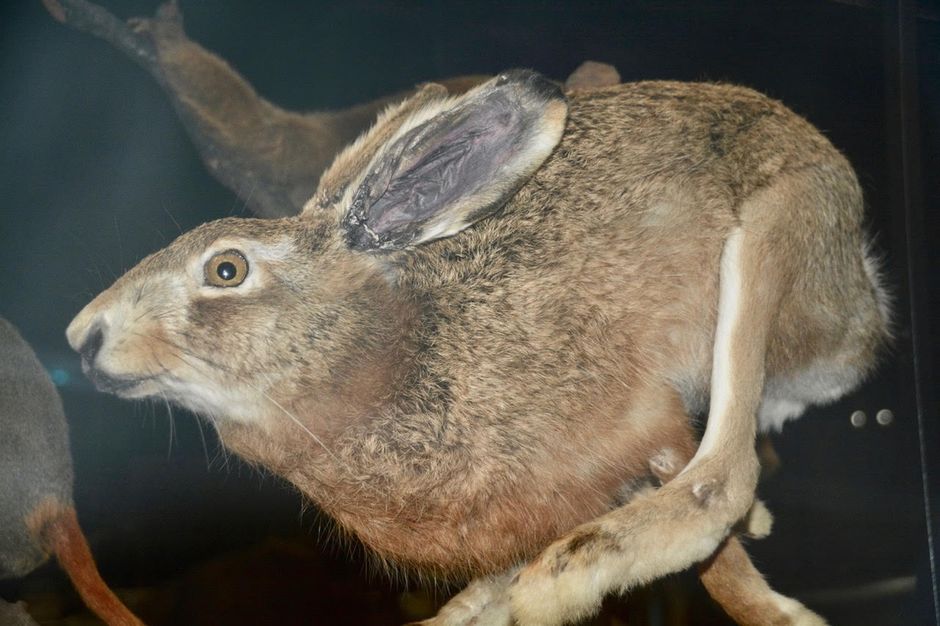The common hare in Palestine, or Cape hare (Lepus capensis) looks like a giant rabbit but, unlike the latter, they have body-hair when they are born and can see, as their eyes are already open.
 A hare. / Photo: Antonio Cruz
A hare. / Photo: Antonio Cruz
And the hare, because it chews the cud but does not part the hoof, is unclean to you. Leviticus 11v6
Hares are only mentioned twice in the Bible (Lev. 11 v 6 and Deut. 14 v 7), despite being relatively abundant in the Holy Land and neighbouring regions.
The reason for this may well be that the Hebrews were forbidden to eat them, according to the stipulations laid out in Leviticus, because though they “chewed their cud” (or at least they appeared to, due to the peculiar way they moved their mouths), they did not have hooves. This prohibition has often been called into question because, in fact, hares are not ruminating animals with a stomach divided into four parts, as cows and sheep are, to enable them to digest partially, then regurgitates, chew and completely digest the grass that they feed on.
Initially exegetes did not know how to deal with this and deduced that the writer of this scripture was adapting to the popular conceptions of his time. However, later scientific studies regarding the behaviour of these animals have confirmed that, although they do not ruminate in the physiological sense, they do ingest part of their own excrement – especially nocturnal excrement – as it is covered with a sticky liquid rich in nutritive substances such as vitamin B, and certain minerals that protect them against certain neurological diseases. Dogs are also known to be able to occasionally eat the excrement of other dogs of their own breed, or even other breeds. The consumption of this material serves to duplicate the time during which the food passes through their digestive tract, which enables them to extract the maximum quantity of nutrients, as well as the microbes present in feces which also supply nutritional value. So the Old Testament is right in considering these mammals unclean animals.
In Hebrew, the word for the hare is arnebeth, a term which is composed of two words: arah, meaning “ruminate” and nib “fruit”. In Arabic it is arneb; in Syrian, arnebo and in Septuagint Greek khoirogryllios and dasypus. Later it was translated into Latin as lepus and cheerogryllus. Although the Hebrews could not eat this meat for religious reasons, other cultures held it in high esteem due to its tenderness and rich protein content. The latter characteristic is precisely why the continued and exclusive consumption of this meat is lethal for human beings, as was witnessed at the end of the 19th century.
In fact, in 1884 only six survivors were rescued from the Adolphus Greelyal expedition to the Arctic, of the 25 that had set sail two years earlier with the aim of exploring northern Greenland. Nineteen members of the expedition died of starvation. Not because they had nothing to eat, but because they only ate the Arctic hares that they hunted.
Now it is known that these animals have virtually no body fat but their meat it rich in proteins. An excess of these proteins caused poisoning because the human liver can only process 300 grams of protein per day. If they consume more, the rest accumulates as a lethal poison which can kill a human being in less than a month. This phenomenon is known as “rabbit poisoning”.
The common hare in Palestine, or Cape hare (Lepus capensis) looks like a giant rabbit but, unlike the latter, they have body-hair when they are born and can see, as their eyes are already open. They are Lagomorpha mammals and of the Leporidae family, which originated in Africa and were brought to Europe, the Middle East, Asia and Australia by human beings. There are a dozen or so subspecies, three of which are present in Bible lands (Lepus capensis aegyptius, L. c. isabellinus y L. c. sinaiticus). They all have large eyes and ears in order to detect the approach of their numerous predators. They have white circles around their eyes while the rest of their fur is dark and greyish. A curious feature of this mammal is that the female tends to be larger than the male.
C. H. Spurgeon wrote the following in his commentary on Psalm 13:
“Faith is now in exercise, and consequently is readily discovered; there is never a doubt in our heart about the existence of faith while it is in action: when the hare or partridge is quiet we see it not, but let the same be in motion and we soon perceive it. All the powers of his enemies had not driven the psalmist from his stronghold. As the shipwrecked mariner clings to the mast, so did David cling to his faith; he neither could nor would give up his confidence in the Lord his God. O that we may profit by his example and hold by our faith as by our very life!”[1]
NOTE
[1] Spurgeon, C. H. The Treasury of David.

Las opiniones vertidas por nuestros colaboradores se realizan a nivel personal, pudiendo coincidir o no con la postura de la dirección de Protestante Digital.
Si quieres comentar o